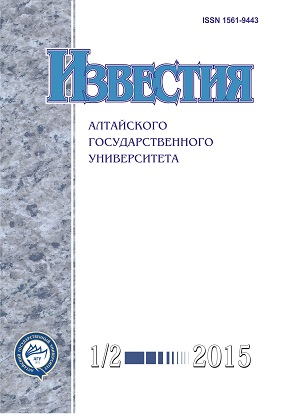Isothermal Motion of Two Immiscible Fluids in a Poroelastic Medium
DOI:
https://doi.org/10.14258/izvasu(2015)1.2-24Keywords:
two-phase filtration, Darcy’s law, saturation, poroelastic, Lagrange variablesAbstract
In this paper, a mathematical model of simultaneous flow of two immiscible liquids in a poroelastic medium are considered. This model is a generalization of the classical Muskat-Leverett model, in which porosity is considered to be a given function of spatial coordinates. The accounting of compressibility of the porous medium is the crucial moment. The proposed model is based on the mass conservation equations for liquids and porous skeleton, Darcy’s law for liquids, the movement of the porous skeleton, the formula for the Laplace capillary pressure, rheological equation for porosity, and the condition of equilibrium “of the system as a whole”. Paragraph 1 provides the formulation of the problem and the conversion of a threedimensional system of equations written in Euler variables. The result is a system of a composite type that, like the classical Muskat-Leverett model, consists of equations with degenerate solutions. A compatibility condition occurs for solid phase velocity. Passing to Lagrange variables results in the closed system of equations free of solid phase velocity.
DOI 10.14258/izvasu(2015)1.2-24
Downloads
References
Коллинз Р. Течение жидкостей через пористые материалы. - М., 1964.
2
Бэр Я., Заславски Д., Ирмей С. Физикоматематические основы фильтрации воды. - М., 1971.
3
Развитие исследований по теории фильтрации в СССР. - М., 1977.
4
Muskat M. The flow of homogeneous fluids through porous media. - Edwards. Ann Arbor, 1937.
5
Антонцев С.Н., Кажихов А.В., Монахов В.Н. Краевые задачи механики неоднородных жидкостей. - Новосибирск, 1983.
6
Жумагулов Б.Т., Зубов Н.В., Монахов В.Н., Смагулов Ш.С. Новые компьютерные технологии в нефтедобыче. - Алматы, 1996.
7
Жумагулов Б.Т., Монахов В.Н. Гидродинамика нефтедобычи. - Алматы, 2001.
8
Connolly J.A.D., Podladchikov Y.Y. Compactiondriven fluid flow in viscoelastic rock // Geodin. Acta. - 1998. - Vol. 11.
9
Connolly J.A.D., Podladchikov Y.Y. Temperature-dependent viscoelastic compaction and compartmentalization in sedimentary basins // Tectonophysics. - 2000. - Vol. 324.
10
Tantserev E., Cristophe Y. Galerne, Podladchikov Y. Multiphase flow in multi-component porous visco-elastic media // The Fourth Biot Conference on Poromechanics. - 2009.
11
Солонников В.А. О разрешимости начально-краевой задачи для уравнений движения вязкой сжимаемой жидкости // Записки науч. семинаров ЛОМИ АН СССР. - 1976. - Т. 56.
12
Папин А.А., Ахмерова И.Г. Разрешимость системы уравнений одномерного движения теплопроводной двухфазной смеси // Математические заметки. - 2010. - Т. 87. - Вып. 2.
Downloads
Issue
Section
License
Izvestiya of Altai State University is a golden publisher, as we allow self-archiving, but most importantly we are fully transparent about your rights.
Authors may present and discuss their findings ahead of publication: at biological or scientific conferences, on preprint servers, in public databases, and in blogs, wikis, tweets, and other informal communication channels.
Izvestiya of Altai State University allows authors to deposit manuscripts (currently under review or those for intended submission to Izvestiya of Altai State University) in non-commercial, pre-print servers such as ArXiv.
Authors who publish with this journal agree to the following terms:
- Authors retain copyright and grant the journal right of first publication with the work simultaneously licensed under a Creative Commons Attribution License (CC BY 4.0) that allows others to share the work with an acknowledgement of the work's authorship and initial publication in this journal.
- Authors are able to enter into separate, additional contractual arrangements for the non-exclusive distribution of the journal's published version of the work (e.g., post it to an institutional repository or publish it in a book), with an acknowledgement of its initial publication in this journal.
- Authors are permitted and encouraged to post their work online (e.g., in institutional repositories or on their website) prior to and during the submission process, as it can lead to productive exchanges, as well as earlier and greater citation of published work (See The Effect of Open Access).








